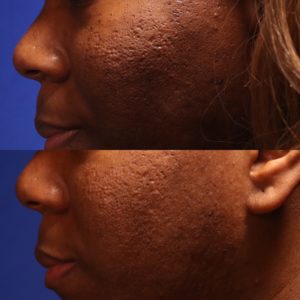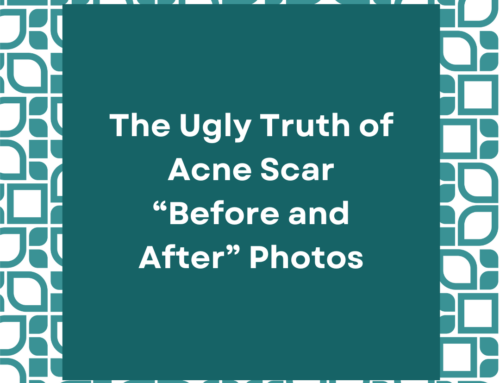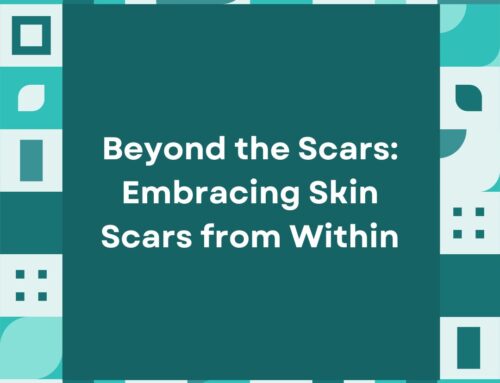Trichloroacetic acid (TCA) is a widely used deep chemical peel for skin rejuvenation. In more recent years, the use of TCA in CROSS treatments has become increasingly more popular for acne scarring. In fact, it has come to rival the more well-known acne scarring treatments today, such as lasers and microneedling, which only scratch the surface of the skin but leave deep ice-pick scars untouched.
In this blog, we are going to dive deeper into the benefits, risks, and common misconceptions associated with TCA CROSS to help you determine if this is the right treatment for you.
How does TCA CROSS work?
CROSS stands for Chemical Reconstruction of Skin Scarring, a term that describes the highly precise technique of applying deep chemical agents, such as TCA, directly into scar tissue. This method is typically performed using fine applicator tools, notably toothpicks and small-tip paint brushes. Almost immediately after the TCA is applied, a characteristic white frost appears, indicating the onset of a deep micro-chemical burn in the scar. The wound eventually forms a scab and ultimately regenerates fresh, healthy skin.
Is TCA CROSS the best treatment for acne scarring?
Getting the best possible treatment outcome for your acne scarring often requires a combination approach. TCA CROSS is particularly effective for ice pick scars but is relatively ineffective for other types of scars, such as rolling scars. Thus, patients with a mixed profile of all three types of atrophic acne scarring – ice pick, rolling, and boxcar – would benefit from TCA and other treatments, such as subcision, dermal fillers, and more.
Interestingly, a split-face study showed that phenol may be a more effective alternative to TCA for CROSS treatment.1 Dalpizzol and colleagues showed that both chemical agents were ultimately effective but that patients reported more side effects with TCA CROSS than they did with phenol CROSS.
Therefore, in discussing CROSS treatment with your dermatologist, it may be wise to perform test treatments with both chemical agents to see which one works best for your skin.
Can TCA CROSS make my scars worse?
Scars worsening with TCA CROSS is a rare occurrence. There are numerous studies showing that TCA can widen scars, but it is not yet confirmed whether this is due to the chemical itself, the application technique, or inherent differences in the patients’ response. In the same split-face study discussed above, it was shown that scars treated with TCA widened for several patients. This was also observed in another study, in which TCA was applied with laboratory pipette tips.
Which TCA peel is the best?
TCA peels come in all concentrations, ranging from as low as 15% to 100%. Low-concentration TCA peels are better suited for full-face application, whereas high-concentration TCA peels are more effective with CROSS application. Generally, the higher the concentration, the more pronounced the effect.
However, one caveat is that if depth of chemical injury exceeds the base depth of the scar that is being treated, there is a potential for worsening of the scar.
Therefore, it is highly recommended that every patient undergo test treatments with varying TCA or phenol concentrations to see which one works most effectively – and safely – for their scars.
How many rounds of TCA CROSS do I need to see results?
Most individuals with predominantly ice pick scars will need 3 to 5 sessions of TCA CROSS to see significant improvement, although this number varies greatly.
For those with severe ice pick scars, TCA CROSS may not produce any results at all. These types of scars may need to undergo punch excision. With this method, the scar is removed with a circular blade and closed with a suture. A small linear wound is left behind, which can then be further improved with lasers or dermabrasion.
What are the risks of TCA CROSS?
TCA CROSS is a highly sensitive technique. It must be performed by an experienced board-certified dermatologist to ensure minimal risk to the patient.
As discussed above, one of the potential risks of TCA CROSS is worsening of acne scars. Off-target application of TCA can create new scars or widen the shoulders of existing acne scars. Additionally, your scars may naturally respond poorly to deep chemical treatments.
Another notable adverse effect is skin discoloration. Discoloration can manifest as hyperpigmentation (darkening of the skin) or hypopigmentation (lightening of the skin). These effects are generally temporary and resolve over time. However, there is always a risk of long-term skin color changes if proper pre operative care and aftercare instructions are not followed.
Is TCA CROSS safe for all skin types?
The risk for skin discoloration is significantly higher for darker skin types, including individuals from a non-Caucasian background. There are several protective measures you can take to drastically minimize your risk of dyspigmentation:
- Pre-treat and post-treat your skin with hydroquinone (bleaching compound).
- Stay out of the sun for at least two weeks after treatment.
- Apply sunscreen every two hours in the presence of sunlight.
- Do NOT pick or remove scabs after treatment.
Is TCA CROSS painful?
Most individuals report a mild to moderate stinging sensation on their skin that persists for up to 1 to 2 hours after treatment. Any residual pain is easily manageable with Tylenol.
What is the downtime or recovery with TCA CROSS?
Scabs will usually fall off within 5-12 days of treatment. When the scabs fall off, you will likely notice fresh, pink skin underneath. The redness is completely normal, as it is a sign of blood bringing oxygen to the treated area, and will last for several weeks to several months depending on the individual.

Conclusion
TCA CROSS is an effective and minimally invasive treatment approach for acne scarring, particularly ice pick scars. It works by creating focal chemical burns in your scars, which scab over and heal to produce fresh, healthy skin. Its known side effects include potential worsening of scars and skin pigmentary changes but are nonetheless avoidable with the right precautionary measures.
Potential alternatives to explore include phenol CROSS, which has recently been shown in one study to produce better results and less side effects. Getting skin tests with each chemical is the best way to determine if TCA or phenol CROSS should be the next step in your acne scar healing journey. Start today with the board-certified Dermatologists at Scar Healing Institute in Beverly Hills, California.
Schedule an Appointment
Scar Healing Institute
Scar Healing Institute is committed to developing the most effective treatments for scarring. Our team of scar revision specialists are continually inventing the latest technologies and formulas to deliver the best results for our patients.




